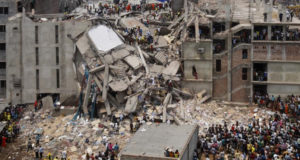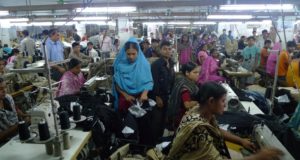Garment waste can potentially generate $4 billion annually. Garment waste management exemplifies the idea of one man's trash being another man's treasure. If tapped correctly, it has the potential of bringing in $4 billion annually.
Read More »Leather industry struggling despite being ‘Product of the Year’
Foreign buyers prefer Bangladesh because of lower wages. China is raising the workers’ wages and concentrating on IT and value added products. The leather industry has been struggling, despite the government declaring it as the “Product of the Year-2017”.
Read More »Survey says 64 percent of Bangladeshi RMG workers can’t meet daily expenses
A survey conducted by IndustriAll Bangladesh Council found that 64 per cent of readymade garment workers cannot bear all the expenses of their daily essentials. The workers need Tk 19,217 as monthly minimum pay to meet their family expenditure but the minimum wage in the sector is Tk 5,300.
Read More »November 22, 2017: No gas line for non-EZ industries and electricity price hike
Every day, CPD RMG Study team reveals what’s on our economic and apparel radar and curates a selection of the best reports, opinion, and analysis you may have missed. Gas line for Industries outside economic zones still a question mark ...
Read More »Can we fill the automation gap in garment manufacturing?
The term “Industry 4.0” or “factory of the future” was coined by the German federal government in the context of its high-tech strategy in 2011. It describes the integration of all value-adding business divisions and of the entire value chain with the aid of digitalisation.
Read More »Policy consistency, governance & international support to secure energy for all: LDC report 2017
Policy consistency, governance and international support are essential to secure transformational energy for all in the least developed countries, according to the Least Developed Countries (LDCs) Report 2017. Achieving the Sustainable Development Goal seven (SDG 7) – universal access to energy by 2030, will require a 350 per cent increase in their annual rate of electrification, the report added.
Read More »Victims of Tazreen Fashions fire still seeking justice
Victims of Tazreen Fashions fire and their families are still crying for justice even five years after the deadly fire that killed at least 112 workers and injured several hundred on November 24, 2012. Several injured victims and relatives of the dead and missing workers said their hope for justice was fading day by day as the trial process failed to make any significant progress over the last five years.
Read More »The high cost of cheap clothes
On the morning of April 24, 2013, a poorly constructed eight-storey garment factory known as Rana Plaza collapsed in Dhaka, Bangladesh, killing more than 1,130 people in a crush of brittle concrete and rebar. It was the worst industrial disaster in the country’s history, but the toll didn’t end when the building fell. Many later died from injuries sustained in the collapse or were permanently physically disabled. Others developed PTSD or other mental health conditions from witnessing the event.
Read More »November 22, 2017: youth employment trends, FSRT deal and WB funding
Every day, CPD RMG Study team reveals what’s on our economic and apparel radar and curates a selection of the best reports, opinion, and analysis you may have missed. ILO records lack of quality jobs for youth There was a ...
Read More »Govt. to relax obligation for trade union registration
Under pressure from the international community and rights groups, the government has finally agreed to ease the requirements for forming trade unions at factories in the next amendment of the labour law. At present, signatures of at least 30 percent of the workers in the factory are needed to form a trade union -- an uphill task for union leaders. Furthermore, many workers do not want to participate in the election process of trade unions out of fear of getting sacked.
Read More » CPD RMG Study Stitching a better future for Bangladesh
CPD RMG Study Stitching a better future for Bangladesh









